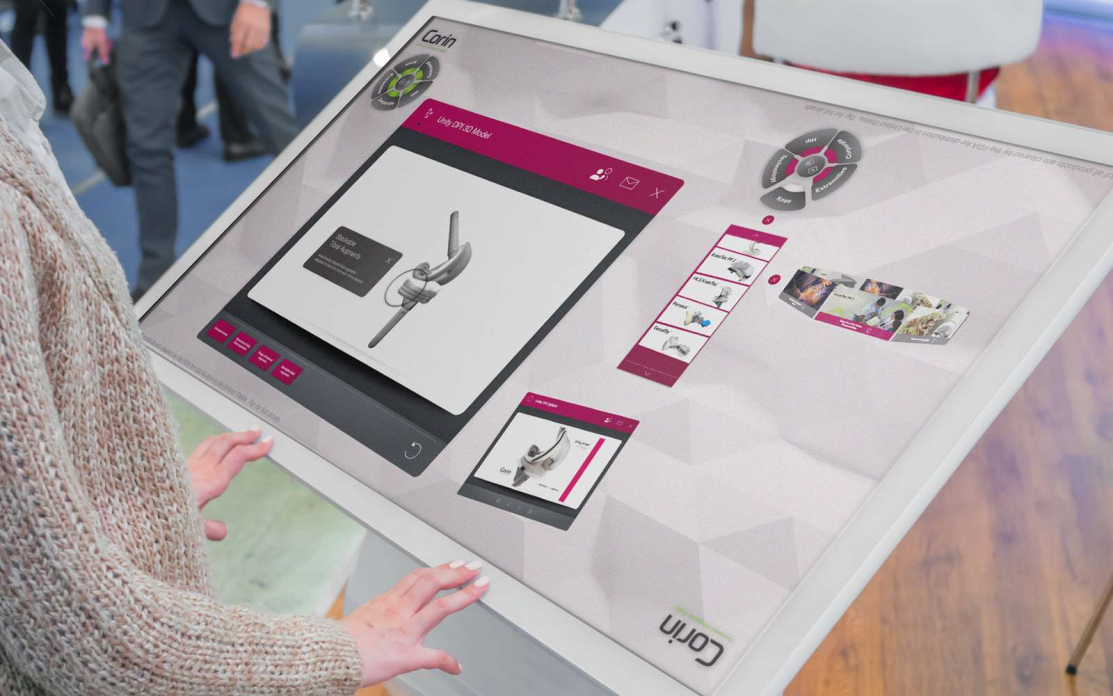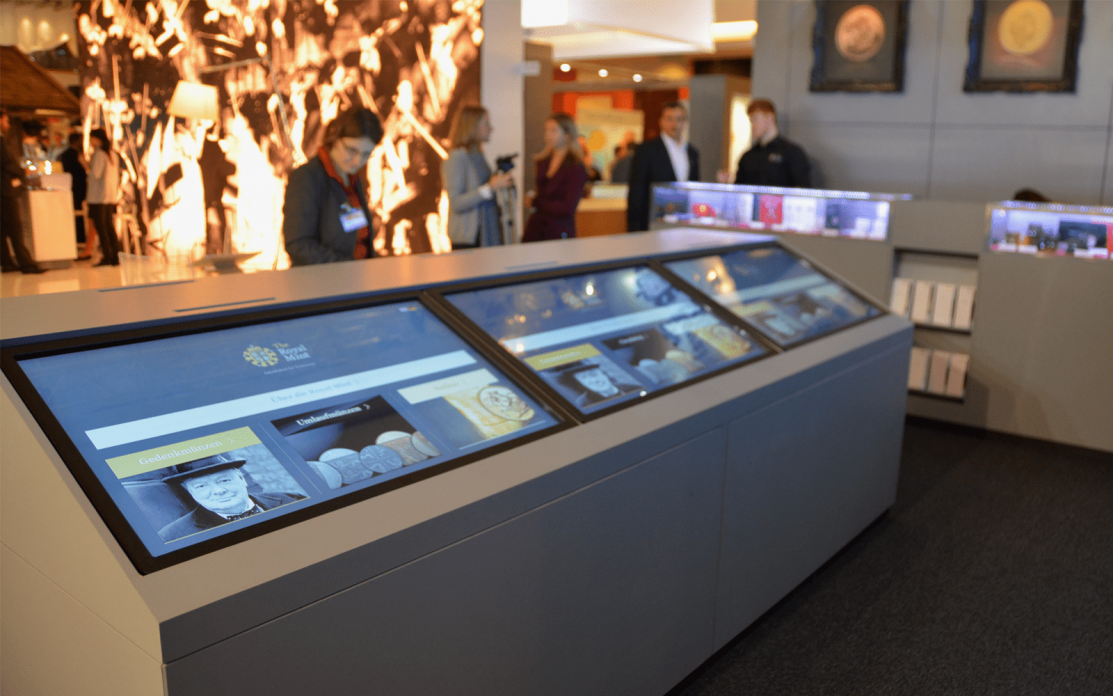If you’re starting to venture into the world of interactive customer experiences for B2B sales, read on as we’ll give you an insight into what’s important to consider.
Interactive touchscreen B2B sales experiences are a great way to create an impact – to catch attention, draw people in and immerse them in an experience that’s completely personal to them but also gives them all of the information they need to know about you, the value that you bring to the table and the opportunities you can create.
As a creative technology business, we work with compnaies to create unique interactive touchscreen experiences and sales enablement tools that drive their business objectives and help them to engage with and win customers.
So, here’s a quick overview of the main steps we go through with our customers when developing an interactive touchscreen b2b sales experience.
Tip: You can achieve a lot with a touchscreen experience. Take a look at these top features!
Our 3-step process to creating interactive customer experiences
1. Know your business objectives
The first thing you have to think about is why you need an interactive b2b sales experience in the first place…
- Why should a customer care about it and use it? What is in it for them?
- What are you trying to achieve?
- Have you thought about what success looks like?
- What do you want people to do or take away from the experience?
- How will you measure the RoI?
- Is this a one-off or is it part of a wider campaign?
- Who is the interactive really for? Is it for your customers to browse on their own or as a guided selling tool?
This might sound like an obvious question but if you aren’t clear about your objectives then the chances are that your content, messaging and user journey won’t all be focussed towards delivering those exact objectives.
Beyond your core objectives, there are wider ones to consider more specifically for the interactive, you may wish to…
- Portray a more innovative and dynamic brand
- Capture leads from the interactive
- Give people access to valuable information which is difficult with printed brochures
- Visualise a complex product/service mix
- Help facilitate more profitable customer conversations for your sales team
- Capture analytics to help you tailor your marketing and sales communications
These are just a few examples of what you can achieve with an interactive, you may need all of them or only a few, and there are plenty more things you can do! But, that’s really where an experienced interactive experiences agency will help. They will know exactly what can be achieved and will help you to draw a picture of what’s possible, suggesting areas you may not have even thought about.
2. Create a robust user experience (UX) and user journey
Once you understand your objectives and those of your customer, the next step is to think about how those objectives will be achieved from the moment a customer walks up to the interactive and starts to engage with the touchscreen experience.
This critical stage is all about the customer, where you need to be asking these types of questions:
- What is the journey you wish to take them on?
- What will resonate with them?
- Will you appeal to individual needs from different sectors, businesses, job roles etc?
- How will you tell your story?
- Is it personal?
- Are the visuals engaging? Will they be remembered?
- Do you have a strong call to action?
- How do you want people to feel during and after the experience?
- Is it easy for people to navigate your experience?
- What sort interactivity should be included?
- How do you keep the conversation going beyond the immediate experience?
The user experience is so important if you don’t get it right you will lose people, they will walk away and that’s the end of a potentially fruitful connection and a waste of your investment on the interactive.
UX in interactives has it’s own rule book too, there is a significant amount of psychology that goes into creating the right UX. Understanding how people interact with touchscreen technology, what appears on the screen, how you navigate them through an experience, giving them just the right amount of help and information to keep them exploring and engaged.
Again, an experienced interactive experiences agency will know all of this and be able to help.
3. Bring it all together with user-centred design
Finally, it’s time to consider what the design will look and feel like. How do you visualise bringing together your objectives, user experience and story and bring it all to life?
We always like to think of the design as the icing on the cake. Or, perhaps more like an iceberg – all the heavy work has gone on behind the scenes, but the real magic is the design on top. It’s visualising the journey you want to take the customer on, and thinking about how to make it engaging, immersive and memorable.
It’s what draws people in, engages them, and helps them to understand who you are, how you help and why you are the only option for them.
A great example is the touchscreen experience we created for SCC. Their technology and infrastructure underpins a large amount of UK and European national, critical infrastructure and that of other global enterprises.
They’re a massive business, but not exactly a household name, despite the fact that most of what goes on in today’s world wouldn’t happen without their technology underpinning it.
We had to think about how to demonstrate that broad scope of services to a vast array of customers whilst reinforcing that scale of importance into an interactive touchscreen experience. We created an SCC world with their customers and sectors sitting on top to demonstrate scale, reach and how they underpin this global world.
Here’s a tip you won’t hear from anybody else
You’ve got to include micro-interactions into your experience.
Micro-interactions are the little animations, visual enhancements that go on when someone is interacting with your experience. At first, they might seem superfluous; most people don’t even really notice them, but these animations are absolutely vital for a good interactive experience. Why?
We’ve all heard about 3-second attention spans? Whether we realise it or not the brain is lazy and gets easily distracted when it’s doing routine tasks, like reading content, looking at a screen. You may think you’re taking on information but your brain isn’t fully engaged it’s skipping over things.
Micro-interactions trick the brain into re-engaging. Subconsciously, your brain registers them and it resets the clock. There is also the risk and reward instinct – if the brain feels it will be rewarded by doing something it will make it easy for you to do it. A button that does something interesting is rewarding the brain. This simple touch encourages the brain to seek out other interesting things to interact with – in other words it keeps you engaged.
Dismiss micro-interactions and you’re making a mistake
TIP: Read our full blog on micro-interactions to learn more about the difference they can make to your interactive customer experience.
So, to summarise…
- Understand your business objectives and those of your customer
- Create a clear and easy journey for your customers so that you make it easy for them to say yes
- Wrap it up in the magic of design.
Would you like to know more about creating an interactive customer experience? Get in touch today on +44 (0)117 329 1712 or hello@popcomms.com. We’d love to hear from you.
Related Posts

Can You Keep Content on an Interactive Touchscreen Display Updated?
Read

Harness the power of Digital Sales Experiences to revolutionize your customer sales.
Read

How to Enhance Customer Experience with Interactive Touchscreens
Read

How to Start Meaningful B2B Sales Conversations With Your Customers
Read